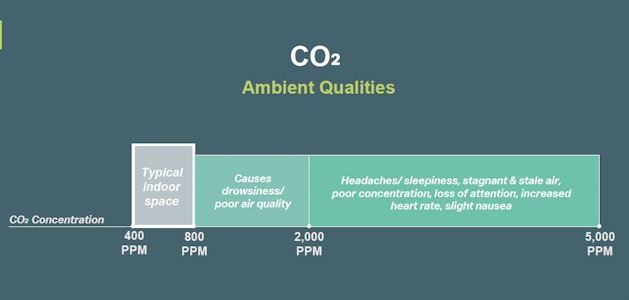How poor environmental quality threatens employee health
The standard of environmental quality in the workplace could be affecting individual and company performance far more than we think. A new guide from AECOM explores the key factors
Ever found yourself yawning in a meeting? Feeling stressed or unable to retain information for any length of time? Having headaches, eye fatigue or dizziness? These symptoms could be caused not by external psychological factors but simply by the poor quality of your environment.
With the average American spending 90 per cent of their time indoors, environmental quality is an issue of growing importance, according to a new presentation from practice leaders Oriana Merlo and Lauren Foisy at multinational infrastructure consulting firm AECOM.
The environmental quality of a building encompasses factors such as light, temperature, air quality, water quality, ergonomics, humidity, vibration, biophilia and acoustics. AECOM’s presentation titled ‘EQ and You: Tracking Environmental Quality to Create Healthier Workplaces’ offers solutions to the common problems that low environmental quality can cause.
Air quality in focus
Air quality is one of the better-known environmental quality factors, but research from the University of Harvard suggests that its impact is even bigger than expected, with estimates putting the productivity benefits of improving air quality at around US $6,500 per person per year.
In order to do this, companies can install air quality monitoring systems that test for levels of pollutants such as PM2.5, PM10, TVOCs, CO2 and Ozone, and display these results to the building’s occupants. They can also install openable widows, maintain humidity levels of between 30-50 per cent, and take other design interventions to ensure that air quality can be kept at a high level.
 Temperature tantrum
Temperature tantrum
Temperature in the office can be a complex issue. Research suggests that with each degree increase in temperature men perform 0.6 per cent worse but women perform 1.8 per cent better. This illustrates how different individuals might perform differently in different environments. To solve this problem, offices can offer hot and cool zones where temperature settings differ in order to provide a range of temperature for all individuals.
Companies can also monitor the temperature in the office to ensure that it falls within optimum levels for summer and winter months.
Without careful consideration of temperature control employees can experience lower levels of mental performance, a lack of focus, an increase in errors, lethargy and even an increase in mistrust of others, all of which can have significant impacts on the smooth running of the company.
Water, water everywhere
Water quality is often forgotten in office environments, but even a small change such as a 2 per cent decrease in brain hydration can results in short-term memory loss and other cognitive difficulties. Poor water quality can cause concentration issues, dehydration, depression, nausea and even gastrointestinal problems if pollutants enter the water supply or contaminate drinking fountains, ice dispensers or coffee machines.
As a consequence, companies should test their water quality quarterly to ensure its safety and incorporate UV sanitizing or water filtration at potable water sources.
The AECOM presentation concludes that the work environment directly affects health and productivity, and that data is needed to identify issues and understand why they might be recurring. However, money spent on creating a healthier building can be recouped through increased productivity and reduced days lost to sickness. Access Merlo and Foisy’s work here and access more from AECOM’s People and Places Advisory team here.








